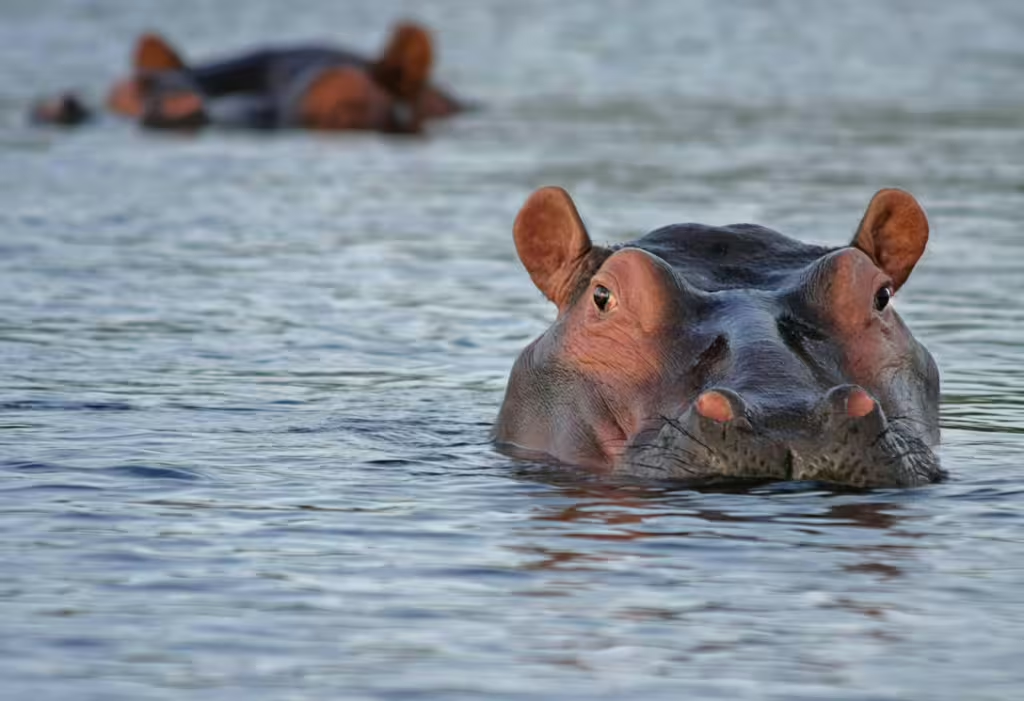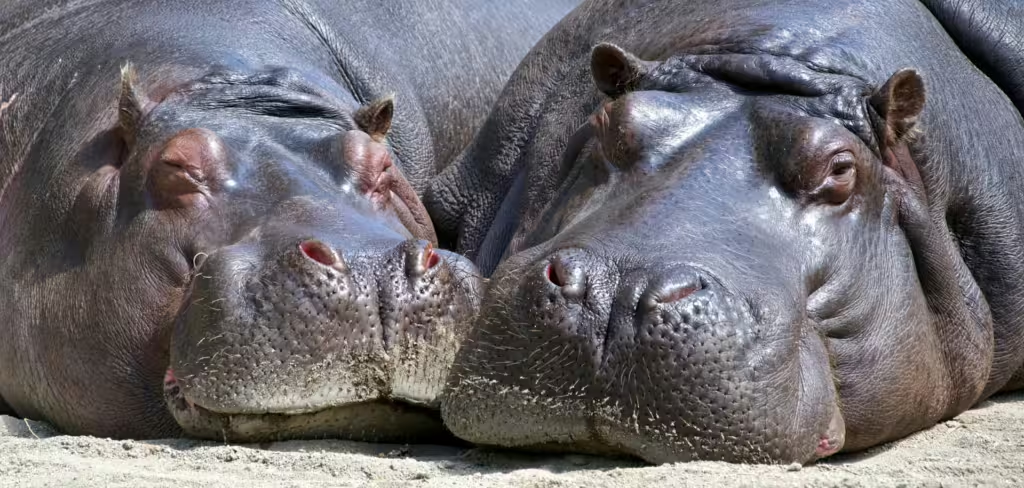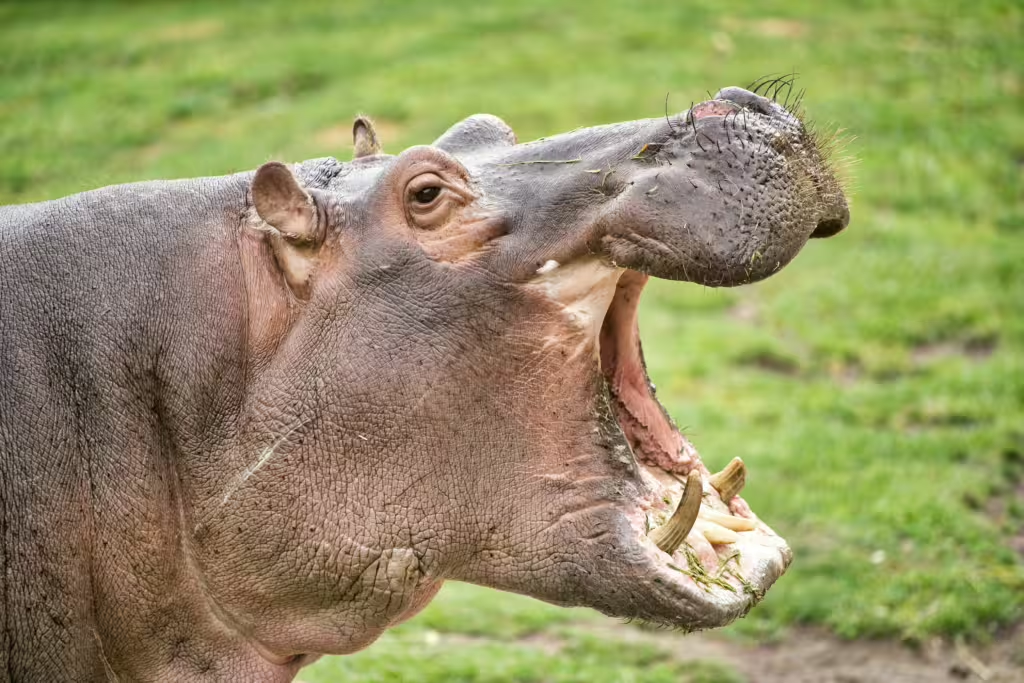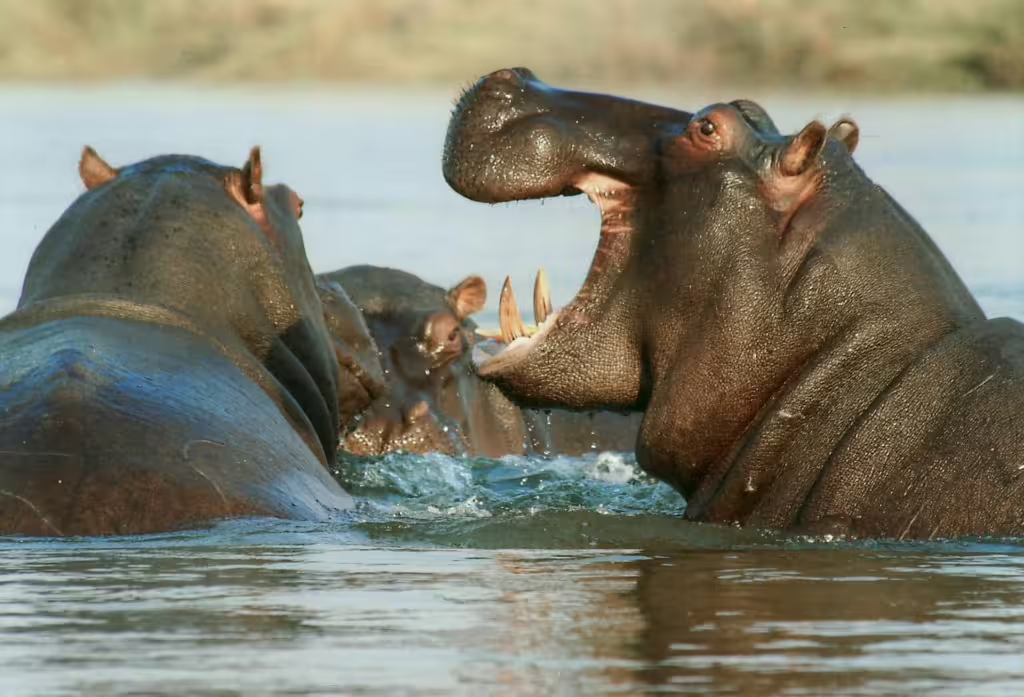On True Investigator, we usually discuss how humans are dangerous to other plants and animals. We are a site that prides itself on environmentalism and our sensibilities tend towards that beyond other concerns. Thus, you could see how it’s something of a rarity for us to discuss animals that might be dangerous to humans, but if any animal could see us flipping the script, hippos would be it.
Hippos, or hippopotamuses, account for more than 500 human deaths each year, that is compared to lions, for example, which only account for 22. Despite their impressive kill count, hippos are some of the most fascinating and paradoxical animals that exist in the natural world. Most people know a hippo when they see one. They are immensely large, distinctive in shape, are well-suited for a semi-aquatic life, and are quite well-known for being aggressive when it comes to protecting their territory.
The thing is, their cantankerous reputation for danger often overshadows the vital role they play within their ecosystems, just as much as it overshadows the subtle beauty that is their biology and behavior. In this article, we will explore why hippos are both dangerous and beautiful. We will examine the unique adaptations that make them so suited to a life on land and in the water, as well as their role in the environment. Finally, we will delve into their unexpected presence in the Amazon rainforest, a place many miles away from their African homeland.
The Duality of the Hippopotamus
The hippopotamus (Hippopotamus amphibius) is a semi-aquatic mammal that has found its way into our collective unconscious for a number of reasons. Not only are we often enamored by their distinctive, rubenesque forms, giant mouths, and singular appearance when compared to other animals, there is also the distinct possibility that deep down in our ancient brains, we fear them. Though hippos are strictly native to sub-Saharan Africa, many of us have been fortunate enough to gaze upon them in zoos, on television, over the Internet, or as plastic and plush facsimiles.
Hippos have barrel-shaped bodies, short legs, and massive jaws, making them instantly recognizable to children and adults alike. And despite their seemingly placid demeanor when lounging in rivers, these mighty quadrupeds are among the most dangerous animals in the entire world, certainly the most dangerous on the African continent. As we touched on earlier, hippos are responsible for more human fatalities in Africa than lions, crocodiles, and any other African predator.
As is our custom here at True Investigator, we aim to look beyond this fearsome reputation to find the real hippo underneath. Deadly though they might be, hippos are beautiful animals that have adapted to life in both water and land in spectacular ways. These adaptations see them embodying a unique blend of power and grace that is unequaled amongst other terrestrial mammals of their size.
Remarkable Adaptations
Hippos have evolved to be quite well-equipped for their semi-aquatic lifestyle. The adaptations they posses make them perfectly suited for life in rivers, lakes, and wetlands, but also for the spats of dry land that abut those habitats:
Aquatic Lifestyle
Submerged Living: Adult hippos are able to hold their breath for up to five minutes underwater. Since they submerge themselves so often, their eyes, ears, and nostrils are positioned on top of their heads. These top-sided traits allow them to remain mostly submerged while staying alert to their surroundings at the same time.
Skin Secretion: Hippos have a lot of skin and it’s mostly hairless, which would mean that living as they do on the African continent, might make them quite vulnerable to one heck of a sunburn. Fortunately for them them, hippo skin secretes a natural sunscreen-like substance, which is commonly referred to as “blood sweat.” Gross as this nomenclature may sound, the substance is quite useful, protecting the hippo’s skin from the sun’s harsh rays.
Blood sweat (well, we got used to it) also has antibacterial properties which can prevent infections. This is particularly important for hippos, whose aggressive tendencies see them getting into serious scuffles with their neighbors and even other hippos from time to time.
Webbed Feet: Hippo feet are partially webbed, allow them to more easily navigate the muddy riverbeds of their habitats. These webbed toes also help them propel themselves through the water, despite their enormous bulk.
Diet and Teeth
Despite having impressively massive, sharp tusks, hippos are generally considered to be staunch herbivores. The large canine and incisor teeth that we are treated to whenever they yawn are used mostly for defense and combat, and they continue to grow throughout the hippo’s life. That said, hippos do eat a lot, consuming more than 80 pounds of grasses and other native vegetation a day. Most of the time hippos graze at night, when it’s cool, and sleep on and off during the day,
Social Structure
If it wasn’t clear from all the talk of infighting and human killing, hippos are highly territorial, especially in water. The water is where dominant males take control of large groups called pods, which consist mostly of females and their offspring. They tend to be less aggressive on land, however, as their territories are not as strictly defined when they are lumbering around. Part of this could be because they are not as agile on land as they are in the water.

The Danger of Hippos
So, why are hippos such unabashed helldozers? Well, their body count stems from hippos’ aggressive behavior, which is a result of their territorial nature and their need to protect access to water, a vital resource for their survival in their hot, African homeland.
Human-Hippo Conflicts
Unpredictable Aggression: While most people, especially the hippos’ neighbors, understand that hippos are highly protective of their space. If a hippo feels threatened, they will attack, unabashedly overturning boats or charging at perceived intruders with reckless abandon. Frankly, if you were a hippo, you too would use their prodigious bulk and strength to threaten anything that remotely threatened you as well.
Injuries and Fatalities: It might surprise you to know that hippos can run up to 19 miles per hour on land. This is despite their size and bulk. Even more surprising, is the fact that this speed makes it nearly impossible for humans to outrun them. If they do catch something, their powerful jaws will make short work of whatever they latch into, as they can crush a crocodile or even a small boat with little enough effort.
Territorial Behavior
In this gross bit of trivia, we learn that male hippos mark their territory by flicking their dung with their tails, a dirty display that also serves as a warning to rivals. We would probably keep our distance in this situation as well. It won’t always deter other males, however, and fights between males for dominance can be brutal, often resulting in severe injuries or death.
Hippos in the Amazon: The Legacy of Pablo Escobar
Deep in the Amazon rainforest, many thousands of miles from their native home in Africa, lives one of the most unexpected populations of hippos. This herd of hippos resides in Colombia’s Amazon Basin and the current population are the descendants of animals imported by the infamous drug lord Pablo Escobar in the 1980s. When Escobar was killed by authorities in 1993, four hippos escaped captivity and established a breeding population in the Magdalena River; and it has caused issues in the region ever since.
The Challenges of Invasive Hippos
Rapid Reproduction: With no natural predators in the Amazon, the Escobar hippo population has grown to an estimated 100 individuals…from four. If you ever wanted a definition of the problems caused by invasive species, this would be it. The current solution is to sterilize the existing “cocaine hippos,” though approaching them to do so poses its own problems.
Environmental Impact: These hippos are a massive (no pun intended) disruption to the local ecosystem. Not only do they competing with native species for resources, their excrement, wallowing behavior, heck, even just their size can seriously alter Amazonian waterways.
Human Conflict: Local communities and human neighbors of the hippos have faced increased risks of hippo attacks for the better part of 30 years, mirroring the dangers posed by their wild hippo cousins in Africa.
While some conservationists argue for the complete removal of the hippos due to their status as an invasive species, others note that these creatures may actually be occupying a potential role in filling ecological niches left by the extinct megafauna that once lived in South America.
Ecological Importance of Hippos
Despite their dangers they pose to nosey humans and just about any unfortunate animal that crosses their path, hippos are absolutely vital to the health of their ecosystems. Their activities within the ecosystem influence water quality, nutrient cycling, and biodiversity in a myriad of ways.
Nutrient Distribution
Hippos spend more time in the water than they do on land, but they tend to feed on land rather than the water. They then defecate in the water, a behavior which transports nutrients from terrestrial ecosystems to aquatic systems. The resultant excrememnt fertilizes water bodies and supports the growth of microorganisms. At the same time, their dung feeds fish and other aquatic organisms, creating a foundation for thriving African ecosystems.
Creating Habitats
The wallowing and grazing activities of hippos shape the physical environment of riverbeds and wetlands, creating habitats for smaller species like fish, amphibians, and insects.
Role as Ecosystem Engineers
Like elephants, hippos are considered both “ecosystem engineers” and “keystone species” because their presence significantly alters and maintains the habitats they inhabit, affecting it in ways that are felt all the way down the food chain.

The Beauty of Hippos
Beyond their ecological importance, hippos possess a unique appearance, a beauty, even that has inspired awe and reverence from humankind for centuries.
Cultural Significance
In many African cultures, hippos are symbols of strength and fertility. These pugnacious pachyderms feature prominently in folklore, art, and storytelling.
Fascinating Behaviors
Hippos communicate with one another through grunts, bellows, and even underwater vocalizations. Much is still unknown about these vocalizations, mainly due to the danger posed by studying them in their watery habitats, so it remains a mysterious subject of scientific scrutiny.
Hippos are fairly social creatures. They will often bask in the sun together or cuddle with their young, showing their innately gentle parental natures. Despite these social bonds and apparent tenderness, male hippos remain quite aggressive overall.
Conservation Efforts
Hippos are presently listed as vulnerable by the International Union for Conservation of Nature (IUCN). This is due to the fact that their populations is continuing to decline with each passing year due to habitat loss, poaching, and human-wildlife conflict.
Threats
Habitat Destruction: Agricultural expansion, dam construction, and urban development have reduced the relative availability of suitable habitats.
Poaching: Hippos, like elephants and rhinos, are hunted for their ivory-like teeth and meat, particularly in regions where there is weak enforcement of wildlife protection laws.

True Investigator Says…
As you can see, hippos are a paradoxical mix of natural beauty, remarkable adaptation, and extreme danger. Their presence in their home ecosystems and indeed, in the Amazonian ecosystems that many have found themselves in, embodies the power of nature. In Africa, hippos play an essential role in the ecosystem, reminding us of the intricate connections that exist between species and their environments. In the Amazon, we see the consequence of introducing such a creature to an unfamiliar place, and the ecological turmoil it can cause.
In the end, the story of the hippo is also a cautionary tale about the consequences of human actions. Whether we look at it from the example of the invasive hippos of the Amazon, to the ongoing threats that African hippos still face in their native habitats, we can see that human beings and hippos probably shouldn’t mix. At the same time, the danger they pose to humans should be indication enough that we need to keep a wide berth, while still working with conservationists to protect and maintain their presence in their native ecosystems.
Discover more from TrueInvestigator
Subscribe to get the latest posts sent to your email.


